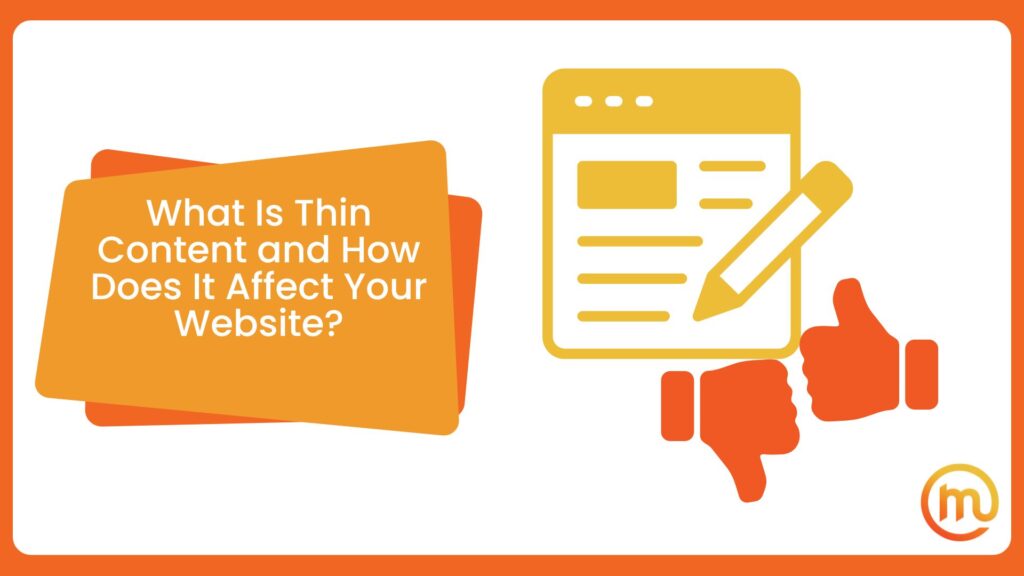Almost 40% of people would leave a website that has poor content. It’s quite understandable – just imagine what it’s like to read a text that just doesn’t deliver. But, what is thin content, and how exactly can it hurt your website? Let’s take a look at it and find the best way to combat it for the best online ranking.
What Is Thin Content Actually?
Content that doesn’t help visitors or add much worth is called thin content. In SEO, this means making pages that don’t have much information on them to trick search engines. If your site has little information, it could hurt its ranking as well as credibility on Google.
Around 96.55% of blog posts don’t get any traffic from Google – and that’s where content marketing steps in. Otherwise, you’ll just waste money and time, and turn people off from your website. With about 200 million active websites, search engines begin to label pages with little information as spam and penalize websites that have them.
Why Doesn’t Google Like Thin Content?
Google wants it to be as easy as possible for people to find the answer to their search queries. People type a search query into the search bar and are taken to the Google SERPs. This is where the most relevant and useful information for their search will show up. As a result, users feel like the material helped them reach their goals, which means Google has done its job.
But still, businesses lose clients, why? Low-quality pages are certainly one of the reasons. Imagine people in need of a top-notch SEO marketing agency. The first thing they’ll do is Google it and click on one of the top results. However, don’t expect that text with no value or useful information will keep people on your website. In fact, users will feel lied to and have to look again as a result. Also, Google doesn’t want people to have to restart their searches, which can be annoying.
Why You Shouldn’t Like It?
Wondering why it takes so long for SEO to work? Well, if your page has text without any value for the visitors, know this could be the reason. It’s also why your content marketing isn’t working. After all, one of the main reasons why your website isn’t doing as well as you wanted, is because of the SEO.
When it comes to SEO, “thin content” means it doesn’t give users anything of value. It’s often short, weak, copied, scraped, doorway, or of low quality. If you want to rank well in Google Search, follow the latest marketing trends and don’t write this kind of material. Google doesn’t like it. Here’s why:
- No backlinks,
- Keyword cannibalization,
- Unhappy visitors,
- High bounce rates,
- Poor backend organization.

Looking Back, Why Do People Use Thin Content in the First Place?
The goal of every online business is to rank high in the SERPs so that they get more traffic, leads, and sales. Did you know that 74% of businesses confirmed that content marketing has helped them get more leads? In the past, this was done by using “black hat” SEO techniques and writing a lot of small, useless material. Those times are long gone, especially when you have a professional content writing agency by your side.
One of the most common things that can hurt your ranking is content like this, so why do people persist with it? Unfortunately, there is still this type of text because of the need to meet word count goals, write pages that only target certain keywords (even if they have nothing to do with the business), or stay competitive.
Types of Thin Content You Should Avoid
There are many types of written topics on the website, but not all of them will bring people to your business. That’s why SEO is important and why you should have an experienced SEO services agency by your side. They can identify the non-valuated text and adequately deal with it. This being said, here are some of the forms that are usually the most common thin content:
- Affiliate pages – pages that you copied from the seller’s site are “thin content” on your site because they don’t add much value or context for your visitors. Also, you need to make it clear that you work for this company. If you don’t, Google will flag it as thin material and take action. It’s better to focus on making affiliate pages that are unique to your site than sending people back to partner sites.
- Automated-generated content – information that is made by software that works on its own. It’s made to get more people to the site without thinking about the information’s quality or relevance; in a nutshell, number is more important than quality. It’s easy to spot because it’s not written by a person and usually has a lot of writing or grammar mistakes. Google can find AI in text, so you should never use text that was made by a computer.
- Doorway pages – duplicate pages that are made to rank for a single keyword and then send people to a different page. Google marks these pages as incomplete to change their results instead of helping searchers find what they’re looking for.
- Pages with little content – pages with only a few words won’t meet the needs of searchers and will get you lower rankings on Google. Use site crawlers (see below) to find pages with low word counts, and then work on making your content longer. Set a goal of more than 500 words, but there is no set word count that will make sure the page doesn’t get labeled as having little information.

Google Panda Update Identifies These Contents
Google punishes websites with insignificant content – from lowering your ranking to taking you off of search results for good. It depends on how bad the situation is.
In fact, Google keeps putting out new changes to its SEO algorithm, like the useful content and the Panda update. In 2011, Google’s Panda Update changed everything by reducing the volume of thin material on the web. People who made content were only paid if they put top-notch material on their websites.
This cut down on the amount of low-quality articles. If Google finds “thin” or unhelpful text on a site, it will drop in the results because of the helpful update. Google is always making changes to its algorithm to find “thin content” in order to fix problems.

How to Fix Thin Content?
When it comes to boosting the website’s rankings, no doubt, the best thing you can do for your business is to hire an SEO agency. The professionals understand the importance of digital marketing, and here are the three steps the best SEO agency takes to fix the text that has no value on a website.
If a page doesn’t have any useful information on it, you can delete it. This works well for landing pages or when a lot of your blogs are about the same term. Or, if you want to keep it, make it more helpful for potential visitors by changing it and adding more content.
Identifying duplicate content is also a major cause of thin content penalties. Review your URLs to find and eliminate similar pages. Look for keywords or article titles that are similar, as these could indicate duplicate articles.
Review your main keywords to check what you’re targeting and where. Multiple blogs targeting the same keywords can lead to keyword cannibalization, where your pages compete against each other. Monitor your keyword rankings and ensure you have a solid keyword strategy to prevent this issue.
Dive Into High Rankings With Top-Notch Content Marketing Agency
Avoiding insignificant articles and texts overall on your website is only one step to your successful and organic ranking. You should find a professional SEO agency that will provide your business with a strategic and comprehensive approach to writing part of the overall marketing plan.
We at Made Online agency will transform your website into a valuable resource that ranks high in search results and captivates your audience. Contact us and discover how our wide range of services can help your enterprise flourish in this competitive digital realm.
Frequently Asked Questions About Thin Content
How Can We Identify Thin Content?
Identify this text by conducting a site audit with SEO tools, checking for low word counts, high bounce rates, and duplicate text.
Why Is Thin Content Bad for SEO?
It’s bad for SEO because it provides little value to users, leading to lower search rankings and potential penalties from Google.
How to Improve Thin Content?
Improve these pages by adding detailed information, original insights, and multimedia elements, and ensuring the text is unique and valuable.
What Does Google Consider Thin Content?
Google considers it as pages with little or no value, including duplicate articles, auto-generated text, and pages lacking substantial information.
What Are the Common Causes of Thin Content?
Common causes are duplicate, auto-generated text, low word count, lack of original research or insights, and poorly written or uninformative articles.

